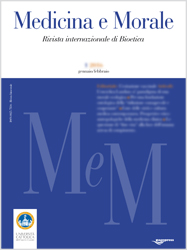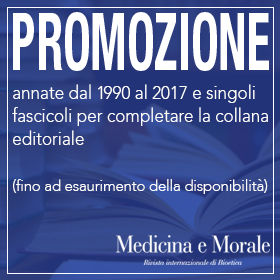Entra per accedere a risorse riservati agli abbonati.
Medicina e Morale. Rivista internazionale di Bioetica è una rivista scientifica trimestrale promossa dall'Università Cattolica del Sacro Cuore (UCSC). La rivista pubblica articoli originali su temi di bioetica, filosofia morale, etica medica, deontologia, filosofia del diritto e discipline affini, come pure casi studio che presentino dilemmi etici rilevanti. Sorta per iniziativa dei Medici Cattolici di Torino, con l'intento di riflettere su temi medico-morali, la Rivista pubblicava il primo numero nel 1951, sotto la direzione di p. Agostino Gemelli, di Pietro Sisto (Professore di Patologia medica speciale a Torino) e di Pietro Rondoni (Professore di chimica biologica nell'Università di Milano). I medici Enzo De Lorenzi e Gian Pietro Ravera formarono la Redazione. Con il n. 1 del 1955 la pubblicazione veniva acquistata dalla Editrice "Vita e Pensiero" della UCSC, rimanendo invariate la Direzione e la Redazione. Nel 1973 la citata editrice decideva di dare ulteriore impulso alla rivista, attraverso un processo di maggiore coinvolgimento della Facoltà Medica. La Direzione veniva assunta dal Prof. Angelo Fiori, medico legale, il Comitato di Direzione e quello di Redazione venivano allargati. Nel 1974 la Rivista acquisiva la collaborazione del Prof. Elio Sgreccia, in seguito Condirettore e quindi Direttore a fianco del Direttore Responsabile Prof. Fiori. La Rivista allargava il suo orizzonte al crescente sviluppo della bioetica di cui veniva anticipata l'espansione anche in Italia, verificatasi alcuni anni dopo. Superate le temporanee difficoltà amministrative del 1983, "Medicina e Morale", gestita ormai dalla Facoltà di Medicina dell'UCSC, giungeva in breve tempo al traguardo di oltre 3000 abbonati, in parte esteri. Nel dicembre 2015, il Rettore dell'UCSC ha emanato un Decreto recante il Regolamento della rivista "Medicina e Morale. Rivista internazionale di bioetica", il quale, unitamente al Codice etico di cui la rivista si era già dato, ne delinea ora la nuova struttura, definendone in modo più dettagliato lo scopo e il ruolo dei diversi organi. Nuovo direttore è stato nominato il prof. Antonio G. Spagnolo, direttore dell'Istituto di Bioetica e Medical Humanities dell'UCSC. Si può dire con legittima soddisfazione, che la Rivista gode di un credito in Italia ed in altri Paesi del mondo, figurando nelle biblioteche di importanti Università e Istituzioni Culturali.



